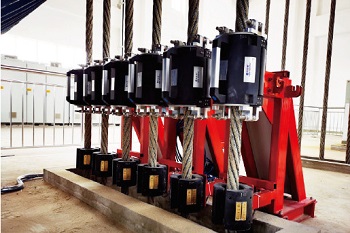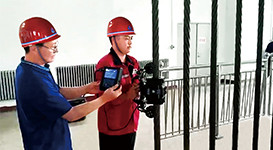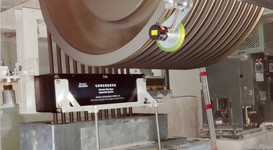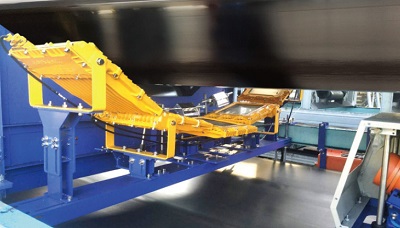
|

|

|

|
The steel wire rope of major lifting equipment in mines is a high-risk component that directly bears the load. Once it fails, it will cause serious accidents that affect production and machine damage. For a long time, due to the lack of scientific and reliable testing equipment, the safe operation of steel wire rope has always been a difficulty in the equipment management process, even a "blind spot". This article details the world's first set of steel wire rope online automatic monitoring system independently developed by China. The successful development of this system not only plays a very important role in helping major equipment steel wire rope users in China overcome the three management contradictions of "hidden dangers, waste, and inefficiency" and achieve the triple management goals of "safety, conservation, and efficiency", but also marks that China's steel wire rope nondestructive testing technology has taken the lead in the world.
CLC No.: TD791 Document Code: C Article ID: 1003-496X (2007) 06-0042-04
An important issue in the use of major lifting equipment steel wire rope is the full-process management of steel wire rope from factory shipment, use, testing, to scrapping. For online steel wire rope in use, it is a crucial link in the whole management system to accurately quantify the detection of various injuries that may occur and timely monitor its changing trend. For a long time, the safety management of steel wire rope has been a worldwide problem because the detection technology in the past cannot complete reliable on-line monitoring of the injury status of steel wire rope.
TCK.W steel wire rope online automatic monitoring system uses a new weak magnetic detection technology, which is the first in the world to successfully solve this technical problem. TCK.W steel wire rope online automatic monitoring system can accurately evaluate the remaining load capacity and service life of the measured steel wire rope through quantitative detection of various injuries of online steel wire rope, and propose evaluation and diagnosis countermeasures based on the test results to give full-process management plans for steel wire rope use.
After nearly a year of research, experiments have shown that TCK.W's weak magnetic detection technology can overcome various factors that affect the detection results, such as the differences in working conditions of different mines, steel wire rope technical characteristics, and elevator features. It has been tested and the results are accurate. It not only solves the three major management conflicts that have long plagued the use of steel wire rope in the group company, but also provides a reliable high-tech means to achieve the group company's "safe, save, efficient" three management goals.
The main components of the system are: load components, detection components, shaping components, following components, structural components, data communication components, alarm indicators and actuators, central processing components, software systems, display terminals, etc.
一、Overview of Security Management System Implementation
![5a4c2b4198472.png _O%]C06HJKPFUS54VZV{X%H.png](/uploads/img1/20180103/5a4c2b4198472.png)
二、Implementation process of online automatic monitoring system
The TCK.W steel wire rope safety monitoring and management system firstly conducts magnetic planning and shaping for the shape changes of the steel wire rope caused by damage and attachments, so that the detection components can smoothly detect the steel wire rope. Secondly, the detection components accurately and precisely detect various parameters of the steel wire rope, which are transmitted to the main control station through wired or wireless, relay devices for comprehensive analysis. Finally, the parameters are displayed on the display terminal through a human-machine interface that is easy to understand. The safety protection function is completed through alarm indicators and execution components.
三、Key points of development technology for each part
1、Load Components
The loading component adopts weak magnetic loading technology to establish a stable and orderly "weak" potential magnetic field on the tested steel wire rope.
2、Detection component
The detection component mainly consists of a housing, a Duo's element, a quality module, a power supply, and input/output interfaces for data. The core element is the "Duo's element", which utilizes the "spatial magnetic field vector synthesis" principle to quantitatively and non-destructively detect steel wire rope. Its sensitivity is tens of thousands of times higher than that of the "Hall element". This technology theoretically studies the relationship between the magnetic field strength and its changes of damage and the distribution of various magnetic field vectors, establishes a mathematical model between them and the damage area (AS) of steel wire rope. By monitoring the main magnetic field (Hz) around the steel wire rope and local magnetic fields (Hi), such as local magnetic fields caused by internal and external broken wires (Hd), magnetic fields caused by internal and external wear (Hm), local magnetic fields caused by internal and external corrosion (Hx), and other magnetic fields such as broken surface reduction and steel wire welding points (Hq), the internal and surface defects of steel wire rope can be determined.
3、Plastic components
During the operation of the steel wire rope, it may be attached to other objects or broken due to fatigue or other reasons. The broken wire will protrude from the surface of the steel wire rope due to the stress on the broken end. These attached objects or protruding wire ends will affect the detection accuracy or damage the detection components. Therefore, before the steel wire rope passes through the detection component, we first perform magnetic planning and shaping on the surface of the steel wire rope. After on-site investigation and listening to the opinions of on-site technical workers and engineering technicians,

Due to the many unforeseeable accident hazards in the use of steel wire ropes, one of the most serious hazards is the broken wire and the damaging impact on the detection equipment caused by the broken wire's protrusion.
To address this potential issue, a set of emergency automatic opening and closing mechanisms have been specifically designed. As shown in the figure, there are two action switches on each end of the damage detection unit. The action device allows objects with a diameter 20% greater than the steel wire rope diameter to pass through, such as broken wires with protrusions and common oily mud and other soft adherences. At this point, the damage detection unit will detect the damage and immediately sound and light an alarm to alert the monitoring personnel. Once the protrusion exceeds 20% of the steel wire rope diameter, the action device will immediately actuate, causing the main unit to rapidly open and stop working within 0.05 seconds, protecting the damage detection unit from harm and generating an emergency alarm. This requires monitoring personnel to quickly inspect the site and identify and remove the cause of the malfunction before the detection equipment can be restarted.
The upper and lower protective shells are used to prevent interference from most falling objects such as water, coal, and mud, as well as larger adherences of steel wire rope, avoiding false positives from the action device.
4、follow-on subassembly
Due to the displacement of the steel wire rope in the horizontal direction during the process of winding it onto the drum in a traction elevator, and the swaying of the steel wire rope during the multi-rope friction lifting process, the detection component is a wrap-around type, with the steel wire rope always centered within the detection component. The swaying and movement of the steel wire rope can cause vibrations and stresses on the detection component, which can lead to damage if not avoided. Therefore, a structural solution was considered to allow the detection component to follow the movement of the steel wire rope. To enable the detection component to detect the status of the steel wire rope in real-time, a follower component was designed.

The so-called regional follow-up refers to using a fixed bracket to circle an active area around the damage detection unit, and then limiting the movement of the damage detection unit within this range, in order to achieve the goal of following the movement of the steel wire rope. 笔记

The so-called steel wire rope rectification refers to using a limit wheel system to restrict the vibration of the steel wire rope within a moving range, allowing it to smoothly pass through a fixed detection component.
At the two ends of the damage detection unit, there are steel wire rope limit devices that can reduce the horizontal amplitude of the steel wire rope to within 5mm, within the vibration range acceptable by the damage detection unit itself, avoiding excessive vibration of the steel wire rope and damaging the detection component.
The limit wheel system is made of non-ferromagnetic wear-resistant materials to minimize any potential impact on the detection process.
5、Structural components
The structural components are mainly designed and fabricated according to the on-site layout, with the framework supporting and fixing the above components. The design scheme takes specific forms depending on the on-site situation.
6、Data acquisition communication component
Realize the function of data acquisition, convert analog signals into digital signals, and perform preprocessing. The components mainly consist of multi-core shielded cables, quick connectors, interfaces, relay stations, and receiving and transferring equipment, completing the task of transmitting detection signals.
7、Alarm indication and execution components
It consists of red, yellow, and green warning lights and relays. After analyzing and processing the detection data with a data acquisition and communication component, the output interface outputs high and low level control relays and warning signal lights to achieve alarm indication and safe braking. This prevents further deterioration of the accident.
8、Central processing components, software systems, and display terminals
The central processing component is composed of CPU chips, RAM chips, ROM chips, and interface chips, which mainly handle the pre-processing of data. It can receive and cache the data uploaded by the data acquisition and communication component, providing initial data for secondary processing. The software system stores the initial data provided by the central processing component in a database and then performs secondary processing, mainly the damage analysis and calculation of data. The parameters in the calculation formula are divided into default pre-processed data parameters and simulated site data parameters. The calculation results are stored in a database and can be classified into historical archive libraries for easy retrieval and query. The display terminal can review or print the damage data analysis report in real-time.
The TCK.W steel wire rope safety monitoring and management system detects and analyzes the daily operation situation of the mine hoisting system's steel wire rope. If during daily hoisting system operation, the steel wire rope experiences damage such as curling, broken wires, fatigue, wear, corrosion, etc., the detection and analysis processing system will provide a detailed report analysis and processing result in a timely manner, and display a complete damage change curve for the steel wire damage changes.
When the damage to the steel wire rope reaches a certain level, the TCK.W detection and analysis processing system will issue a damage warning signal to alert operators to strengthen attention and maintenance of the steel wire rope. When the damage exceeds the prescribed damage limit, an alarm will be triggered to prompt users to replace the steel wire rope as soon as possible to ensure the safety of production needs.
Simultaneously, for research purposes, the detection and analysis system will store a large amount of data on the long-term operation of the steel wire rope, so that researchers can obtain raw data and analyze the trend of damage to steel wire rope under different lifting conditions, providing a scientific basis for understanding the damage process.
To meet the future expansion needs of the system, the detection and analysis processing system will adopt a modular structure, with each module achieving a certain function and modules being logically connected to each other to form the overall detection system. When designing modules, the future expansion needs of the system will be fully considered.
Currently, the TCK.W steel wire rope safety monitoring and management system has been installed in three pairs of mines of Fengfeng Group. Practical experience has proven that the system provides a reliable safety guarantee for the management of steel wire rope usage. It has replaced the outdated method of checking steel wire rope by hand and naked eye inspection.
About the author: Ji Qingya, male, born in 1968. Graduated from Chongqing University with a bachelor's degree in computer technology and its application. He has been engaged in mining electromechanical technology and administrative management. Now he works in the Coal Production Department of Fengfeng Group Co., Ltd.
上一篇: Application of TCK·W wire rope online monitoring system in coal mines
下一篇: Application of TCK.W Wire rope online automatic monitoring system in coal mine safety management
The application of TCK.W wire rope detection technology in academic journals
Editor's note: TCK.W has developed a weak magnetic rope detection technology that can real-time monitor the status of steel ropes 24 hours a day, 365 days a year, and locate, classify, and quantitatively identify various internal and external defects. Currently, more than 2,500 clients in 42 countries worldwide are using this technology. These clients have published papers on the safety and economic benefits brought about by this new technology in various academic journals. Here is a compilation of some of these papers for experts and scholars to explore and study in depth.。
论文名称
作者单位

 publish:《Coal mine safety》
publish:《Coal mine safety》